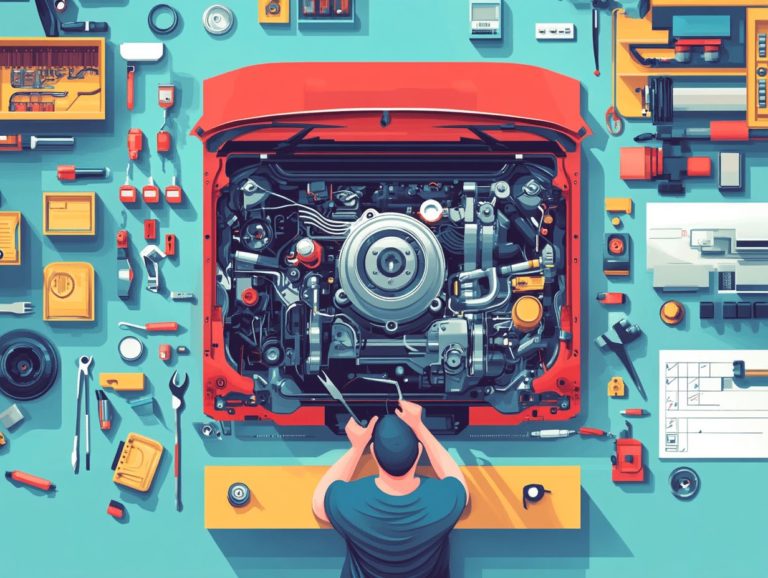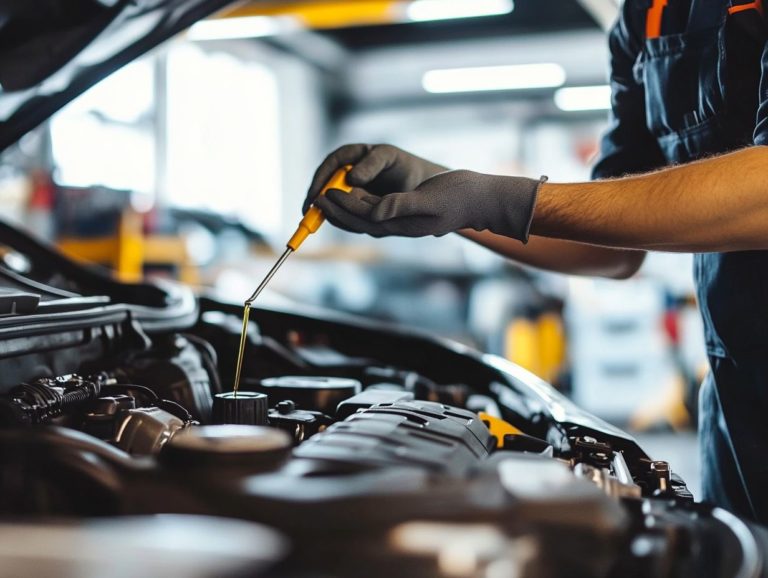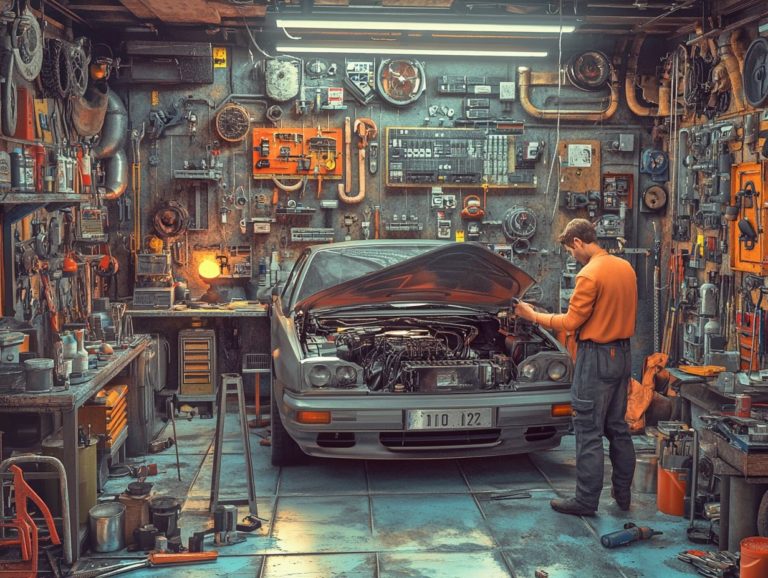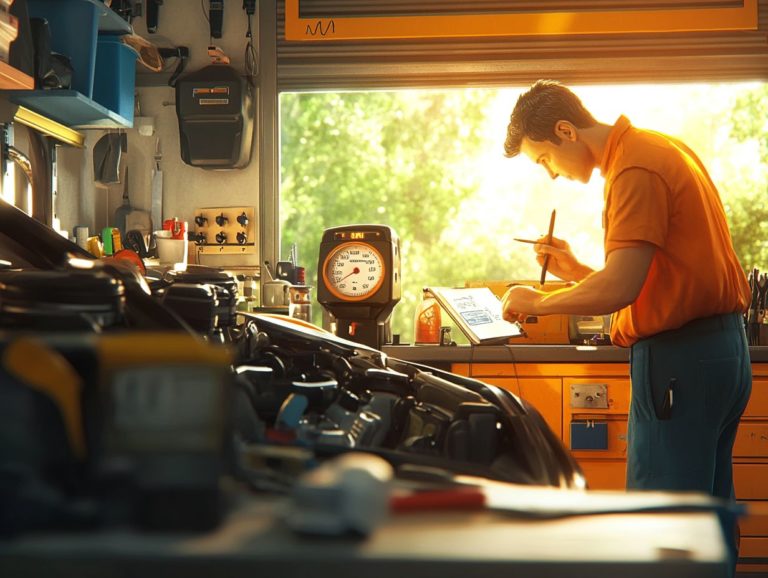The Essential Maintenance Checklist for New Cars
Owning a new car is not just an exciting journey; it also brings many responsibilities that can t be overlooked. Regular maintenance is vital for ensuring your vehicle operates smoothly and safely.
This essential maintenance checklist covers everything from checking oil and fluid levels to inspecting tires and brakes.
By following these steps, you can mitigate costly repairs and significantly extend your car’s lifespan. Are you ready to keep your new ride in pristine condition? Let s explore the critical checks that every discerning car owner should perform.
Contents
- Key Takeaways:
- 1. Check the Oil and Other Fluid Levels
- 2. Inspect the Tires and Tire Pressure
- 3. Test the Brakes and Brake Pads
- 4. Check the Battery and Electrical System
- 5. Inspect the Belts and Hoses
- 6. Check the Air Filters
- 7. Inspect the Lights and Signals
- 8. Test the Wipers and Wiper Fluid
- 9. Check the Cooling System
- 10. Check Your Exhaust System for Leaks Now!
- 11. Test the Steering and Suspension
- 12. Check the Transmission and Drivetrain
- 13. Inspect the Exterior and Interior for Damage
- 14. Test the Heating and Air Conditioning
- 15. Check for Any Recalls or Safety Issues
- Frequently Asked Questions
- What is the essential maintenance checklist for new cars?
- Why is it important to follow the essential maintenance checklist for new cars?
- What should be on the essential maintenance checklist for new cars?
- How often should you follow the maintenance checklist?
- Can you perform the maintenance tasks yourself?
- What happens if you skip the maintenance checklist?
Key Takeaways:
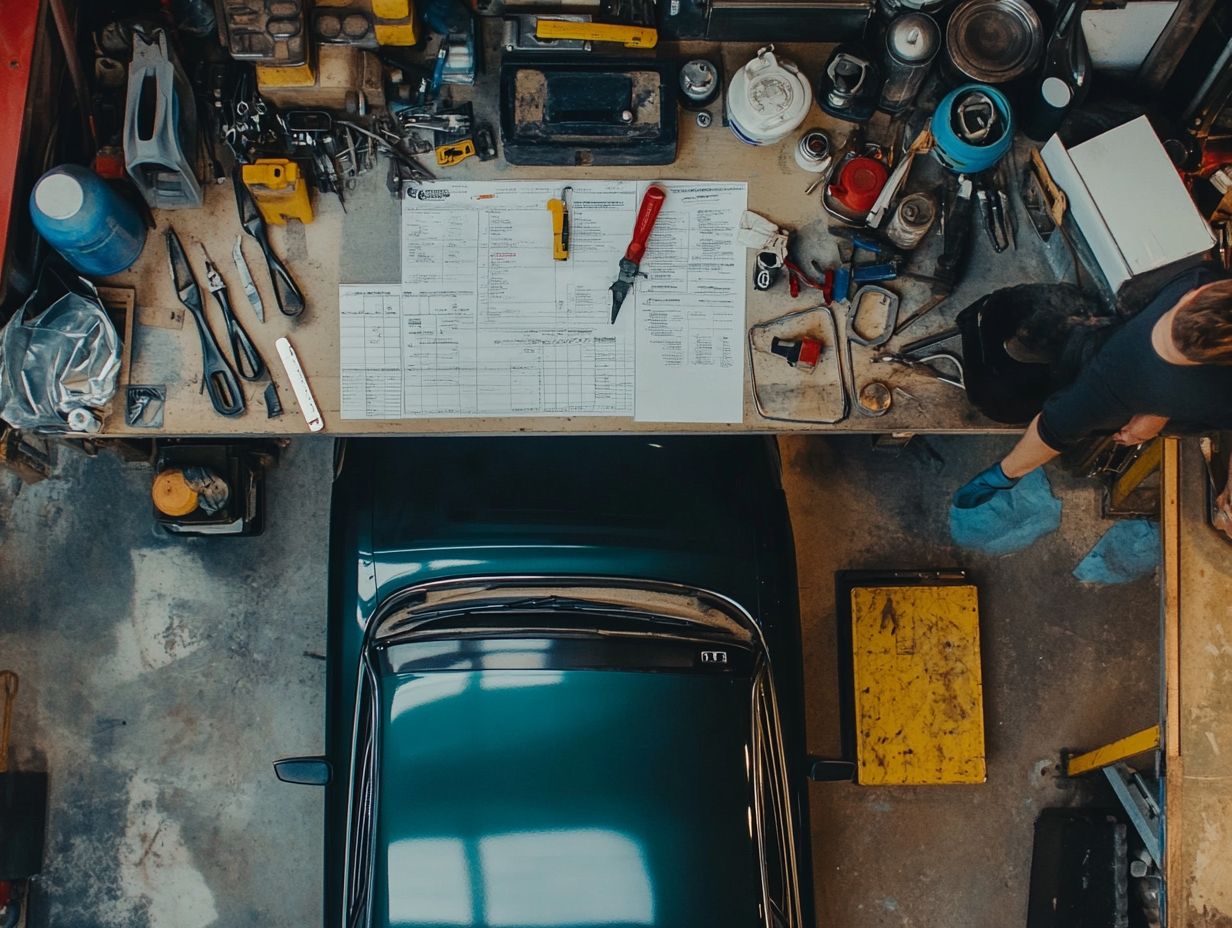
- Regularly check oil and fluid levels to maintain your new car’s performance and longevity.
- Ensure properly inflated tires and functioning brakes for safety and optimal handling on the road.
- Maintain the battery, electrical system, and other components to prevent unexpected breakdowns and costly repairs.
1. Check the Oil and Other Fluid Levels
Proper car maintenance starts with checking essential oil and fluid levels, which are crucial for your vehicle’s performance and longevity. This ensures that components like the engine, transmission, and cooling system operate efficiently and safely.
Among the various fluids to monitor, oil level is paramount. It lubricates the engine’s moving parts, reducing friction and preventing wear. Don t overlook the coolant antifreeze it s essential to prevent overheating and ensures that the engine operates within a safe temperature range. Also, keep an eye on the automatic transmission fluid, as it plays a vital role in enabling smooth gear shifts.
Your owner’s manual is an invaluable resource, offering specific guidance on where to locate these fluid reservoirs and how to measure their levels correctly. Regularly inspecting these fluids can help you avoid issues like the dreaded check engine light activation, keeping your vehicle in optimal condition for years to come.
2. Inspect the Tires and Tire Pressure
Regularly inspecting your tires and maintaining the correct tire pressure are essential for vehicle maintenance. This significantly influences your safety, fuel efficiency, and overall driving experience.
Ensuring your tire pressure meets the recommended levels not only optimizes your contact with the road but also extends the life of your tires. You can easily measure tire pressure with a simple gauge, available at most automotive shops or gas stations equipped with air pumps.
Checking the tread depth is equally crucial; adequate tread provides optimal grip and minimizes the risk of hydroplaning, which occurs when your tires lose contact with the road due to water. A penny works wonders here just place it upside-down in the tread to see if it s still deep enough.
Regular tire rotation prevents uneven wear, enhancing both fuel efficiency and safe handling. By adopting these practices, you can look forward to smoother rides and potentially reduced fuel costs.
3. Test the Brakes and Brake Pads
Testing the brake system and inspecting the brake pads are fundamental aspects of maintaining your vehicle. This guarantees that your car stops efficiently and safely in various driving scenarios.
When you assess your brakes, it s essential to observe their responsiveness; they should engage promptly with just a light press on the pedal. If you hear any unusual sounds, like squeaking or grinding, it s a clear sign that worn components may need your immediate attention.
Regularly replacing brake pads is crucial, as old or damaged pads can cause excessive wear on the rotors, jeopardizing the entire braking system. By keeping these elements in check, you enhance your vehicle’s performance and significantly contribute to the safety of everyone traveling with you on the road.
Take action today start following these maintenance steps to keep your car in top shape!
4. Check the Battery and Electrical System
Checking the battery and electrical system is essential for vehicle maintenance. A well-functioning battery keeps all your electrical components operating smoothly, helping you avoid unexpected breakdowns that can throw a wrench in your plans.
To maintain this critical connection, regularly inspect the battery cables for any signs of corrosion. Look out for that pesky white, crusty substance around the terminals. This buildup can seriously block electricity from flowing, leading to frustrating weak starts or annoying intermittent electrical issues.
By ensuring that your connections are tight and secure, you can sidestep problems like flickering lights or a stubborn starter. Regularly examining these elements boosts your vehicle s performance and extends the battery’s lifespan. This highlights the importance of routine checks in ensuring you stay on the road without a hitch.
5. Inspect the Belts and Hoses
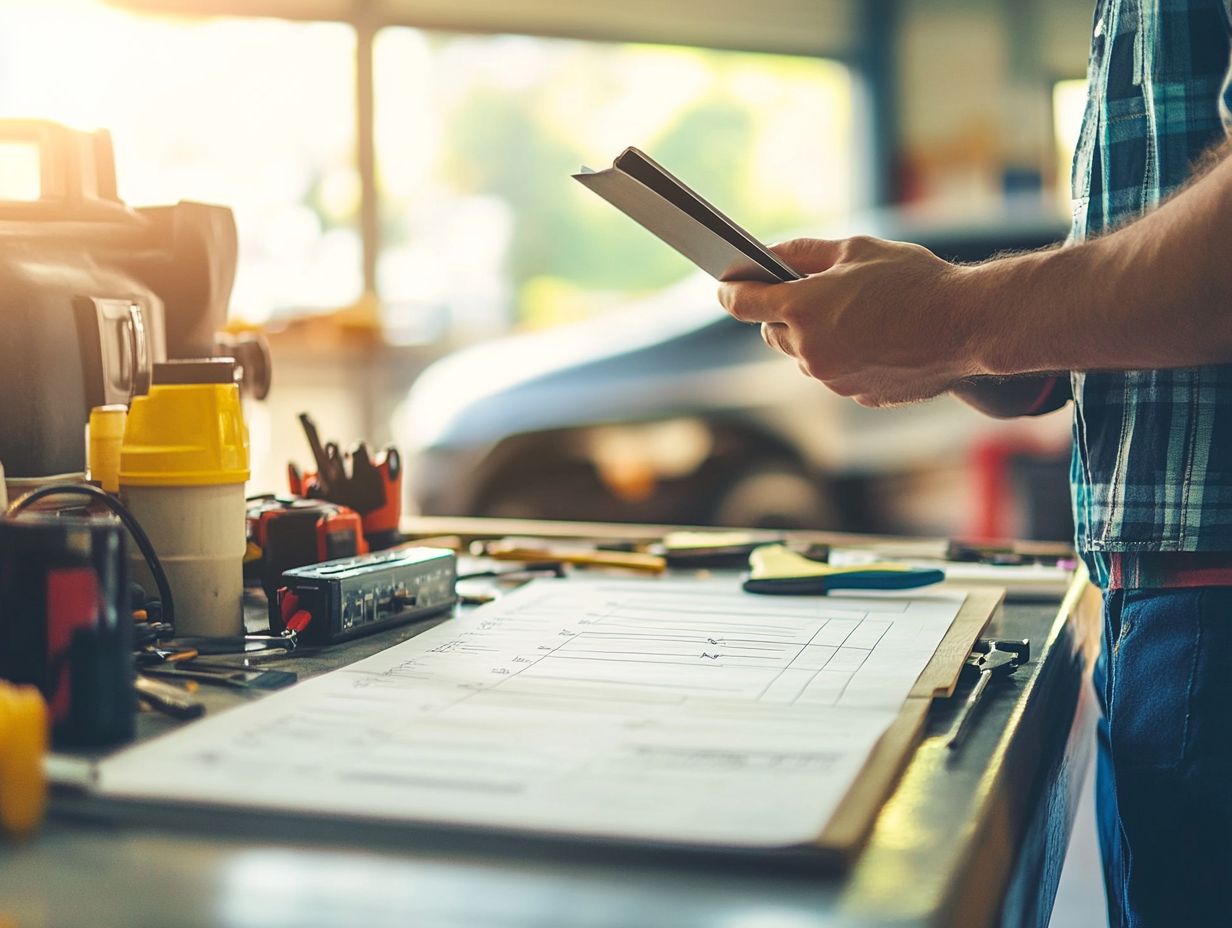
Inspecting belts and hoses is crucial for maintaining your vehicle. Worn or damaged components can lead to serious mechanical failures and impact your car’s overall performance.
Regular checks help you spot signs of wear, such as cracks, fraying, or swelling. These may indicate a risky situation. It s particularly important to pay attention to coolant hoses, as they are vital to your vehicle’s cooling system; they ensure the engine operates at an optimal temperature.
By embracing a proactive maintenance routine, you can significantly reduce the risk of overheating. This helps you avoid costly repairs that arise from neglecting these essential components. Understanding these aspects enhances your safety and extends your vehicle’s lifespan.
6. Check the Air Filters
Regularly checking and replacing your engine air filter is essential for optimal car maintenance. A clean air filter enhances fuel efficiency and ensures your engine performs at its best.
When the air filter is dirty, it can severely restrict the engine’s airflow. This translates to diminished power and torque output, meaning the power your engine uses to make your car move. This inefficiency forces your engine to work harder, leading to increased fuel consumption that ultimately strains your wallet.
To keep your vehicle running at peak performance, inspect the air filter with every oil change and replace it approximately every 12,000 to 15,000 miles, or as specified by the manufacturer. If you frequently drive in d dusty or urban conditions, consider checking more often to maintain smooth engine operation.
7. Inspect the Lights and Signals
Inspecting the lights and signals on your vehicle is a crucial aspect of maintenance. Functional headlights and indicators are vital for safe driving, especially at night or during adverse weather conditions.
When you ensure that each light is operational, you enhance your visibility and make your vehicle more noticeable to others on the road. Start by checking the brightness and clarity of your headlights; a dim light might signal that a replacement is needed.
Next, take a moment to inspect the brake lights. Have someone else stand behind your vehicle while you apply the brakes to confirm they activate promptly. Don t forget to test the turn signals in both directions to ensure they’re functioning correctly.
Have you checked your lights lately? Replacing any burnt-out bulbs in a timely manner is essential. It helps prevent potential accidents and maintains the reliability of your vehicle’s lighting system.
8. Test the Wipers and Wiper Fluid
Testing your wiper blades and monitoring wiper fluid levels are key to keeping your vehicle safe and reliable! These checks enhance visibility and safety during inclement weather.
Regularly inspecting your wiper blades for signs of wear like cracks or frayed edges can save you from the frustration of streaking and smearing on your windshield, which can drastically impair your vision. It’s equally crucial to maintain a full wiper fluid reservoir. Having enough fluid on hand allows you to effectively remove dirt and grime, improving overall clarity.
Clear visibility is paramount for safe driving, especially in adverse conditions like rain or snow. Any impairment can lead to dangerous situations on the road. By prioritizing these straightforward maintenance checks, you ensure a safer driving experience for yourself and everyone else.
9. Check the Cooling System
Regular checks of your cooling system, including coolant levels and antifreeze quality, are essential for preventing engine overheating and ensuring optimal vehicle performance.
This process typically involves locating the coolant reservoir and checking the level against the marked indicators. Inspect the fluid’s color and consistency for signs of contamination or degradation. If the coolant looks murky or rusty, it’s time to clean out the old coolant.
By maintaining the cooling system, you not only prevent overheating but also extend your engine’s lifespan and optimize fuel efficiency. Keeping your coolant fresh can significantly enhance your engine’s performance and reliability, ultimately helping you avoid costly repairs in the future.
10. Check Your Exhaust System for Leaks Now!
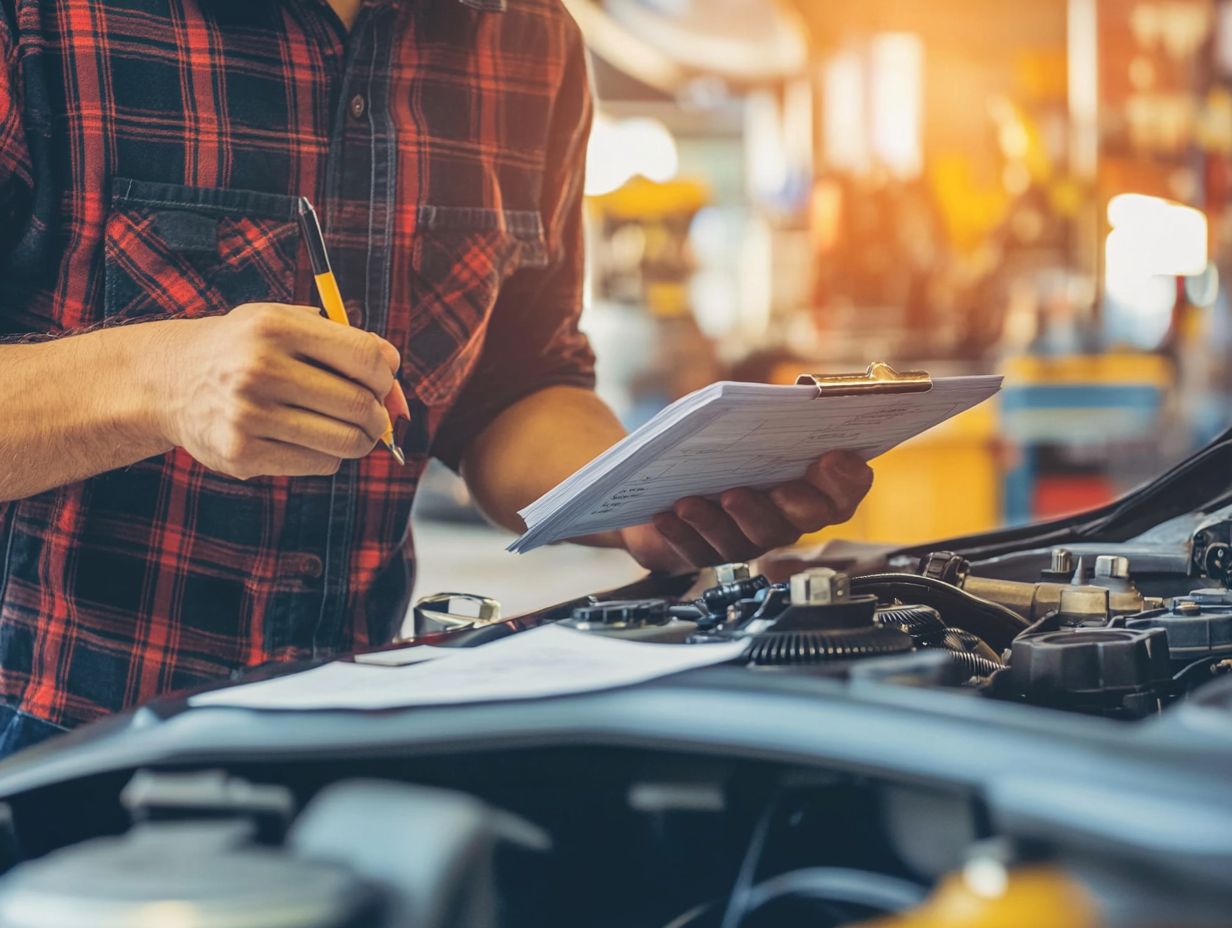
Inspecting the exhaust system for leaks and damage is crucial for maintaining your vehicle. A well-functioning exhaust ensures optimal engine performance while complying with environmental regulations.
Regular checks can unveil issues that might escalate into significant problems down the road. As you examine the exhaust, watch for signs of rust or corrosion. Listen for unusual sounds that might indicate leaks.
If you notice a drop in fuel efficiency or experience a rough idle, these could be critical warning signs of exhaust system damage. A compromised exhaust doesn t just hinder the engine s performance; it can also lead to increased emissions. Therefore, routinely assessing your exhaust system for potential faults is vital.
11. Test the Steering and Suspension
Testing the steering and suspension systems is essential for your vehicle’s maintenance. These components directly influence handling, ride comfort, and safety on the road.
When your vehicle’s steering is responsive, you can maintain control during maneuvers, especially in emergency situations. The suspension system absorbs shocks from uneven terrain, enhancing your ride quality. A well-functioning suspension minimizes vibrations and ensures your tires maintain proper contact with the road, leading to improved traction and braking performance.
Regular assessments help you diagnose potential issues before they escalate, contributing to a more enjoyable driving experience. This reinforces the importance of these systems in safeguarding both you and your passengers.
12. Check the Transmission and Drivetrain
Checking the transmission and drivetrain is an important part of taking care of your vehicle. These systems play a crucial role in power delivery and overall functionality.
Ignoring the signs of transmission issues can lead to bigger problems. Common red flags include unusual noises, slipping gears, or the warning light that lights up your dashboard.
To keep everything running smoothly, it s essential to regularly inspect your fluid levels. Low or dirty transmission fluid can lead to overheating and damage. By routinely checking these levels and replacing any worn-out fluid, you can significantly cut down the risk of expensive repairs while extending the life of your vehicle.
Regular maintenance boosts your vehicle s performance and provides you with the peace of mind to enjoy your drives.
13. Inspect the Exterior and Interior for Damage
Inspecting both the exterior and interior of your vehicle for damage is a crucial part of taking care of your vehicle. This serves to enhance aesthetic appeal while ensuring functionality and safety.
As you examine the exterior, pay close attention to any scratches or dents. These imperfections not only diminish your car’s appearance but could also hint at underlying issues, such as the potential for rust.
Equally vital is checking the interior for signs of wear, including fraying upholstery or torn mats. These factors can impact your comfort and overall driving experience.
Addressing minor scratches, dents, and interior issues promptly can prevent them from escalating into more significant problems that might entail costly repairs later on. Regular upkeep can save you a considerable amount of trouble and expenses, ultimately prolonging the life of your vehicle.
14. Test the Heating and Air Conditioning
Testing the heating and air conditioning systems in your vehicle is crucial for maintenance. This ensures both comfort and safety for everyone on board, no matter the weather.
Regular checks are essential. They allow you to spot potential issues before they become major headaches while enhancing the efficiency of your systems for better fuel economy.
Here are some straightforward steps to keep in mind:
- Examine the air filters and make sure they re clean, as clogged filters can restrict airflow and put unnecessary strain on the system.
- Assess the thermostat settings to ensure they re optimal.
- Listen for any unusual noises that might raise a red flag.
- Check for any strange smells that could indicate a problem.
Make these routine checks a priority to enjoy a comfortable ride and extend the lifespan of your heating and AC systems.
15. Check for Any Recalls or Safety Issues
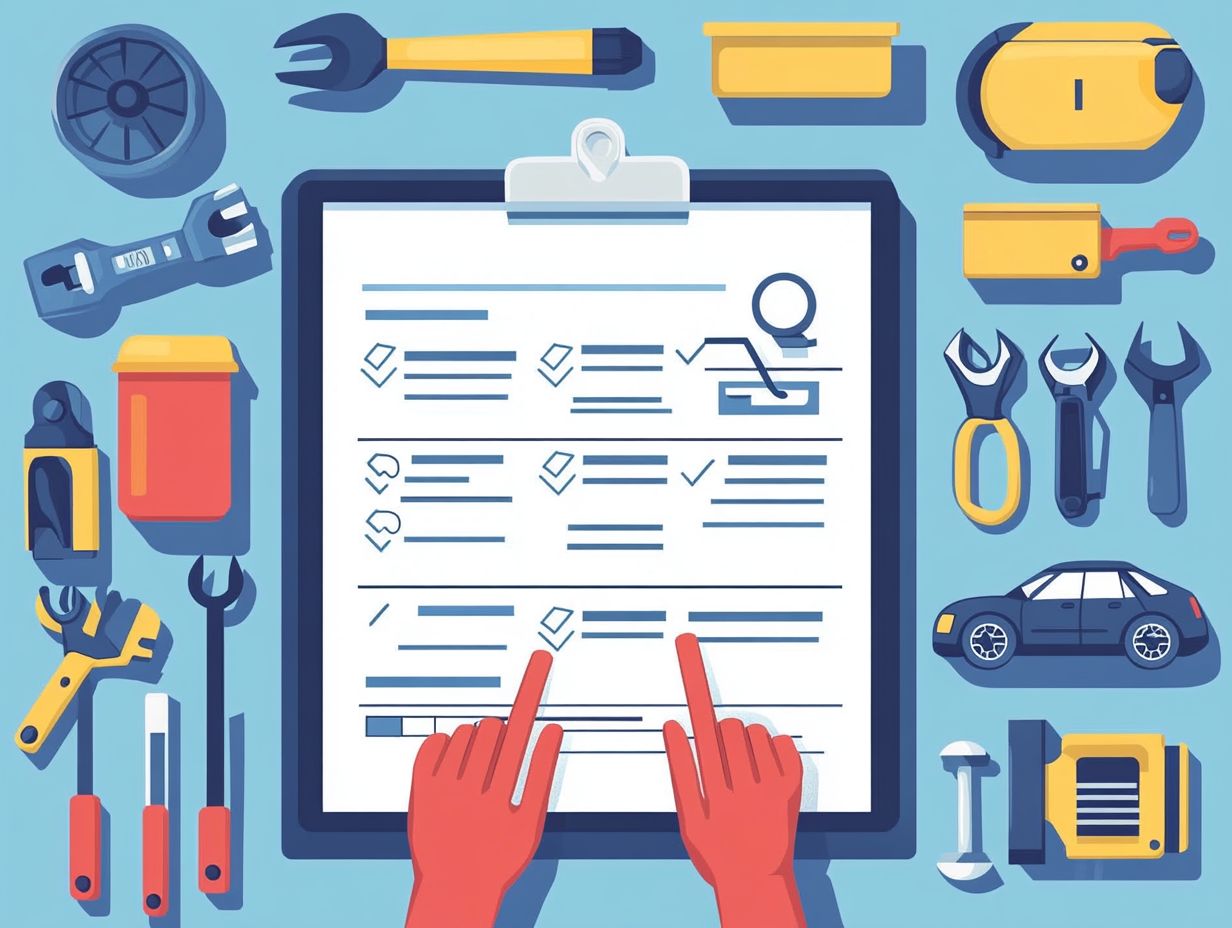
Checking for recalls or safety issues is an essential part of maintaining your vehicle. This ensures it meets safety standards and operates reliably.
To stay informed, make it a habit to regularly visit manufacturer websites, subscribe to safety alerts, or use dedicated recall-checking tools. Addressing any identified safety concerns promptly can significantly lower the risk of accidents and mechanical failures.
Ultimately, understanding and acting on recall information not only protects you as the vehicle owner but also safeguards everyone sharing the road with you. Stay alert and prioritize safety!
Frequently Asked Questions
What is the essential maintenance checklist for new cars?
The essential maintenance checklist for new cars includes a variety of regular tasks that should be performed to ensure optimal functioning and longevity, such as those outlined in the ultimate car maintenance checklist.
Why is it important to follow the essential maintenance checklist for new cars?
Following the essential maintenance checklist for new cars is important because it helps keep the car in good condition, preventing breakdowns and ensuring safety while driving. For a comprehensive guide, check out the ultimate checklist for seasonal car maintenance.
What should be on the essential maintenance checklist for new cars?
Include oil changes, tire rotations, brake inspections, fluid checks, and air filter replacements in your checklist.
How often should you follow the maintenance checklist?
Follow the checklist based on the manufacturer’s recommended schedule. Typically, this is every 5,000 to 7,500 miles or every 6 months, whichever comes first.
Can you perform the maintenance tasks yourself?
You can check tire pressure and top off fluids on your own. However, a trained mechanic should handle the complete checklist for thorough maintenance.
What happens if you skip the maintenance checklist?
Neglecting the checklist can lead to poor performance and increase the chance of breakdowns. This may result in costly repairs down the line.
Stay ahead of potential issues by following this checklist regularly!


